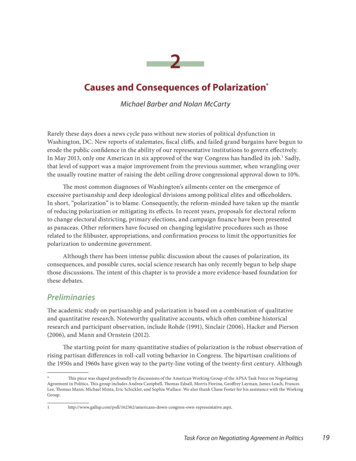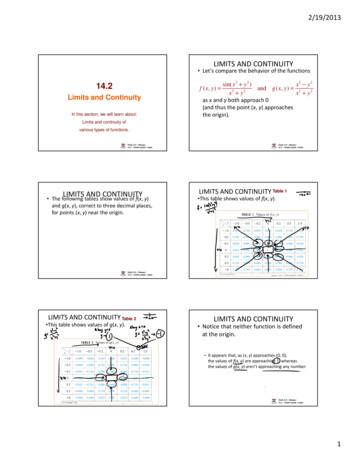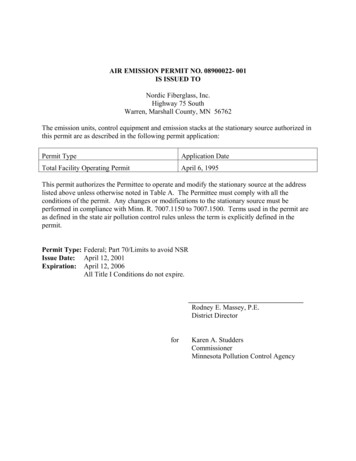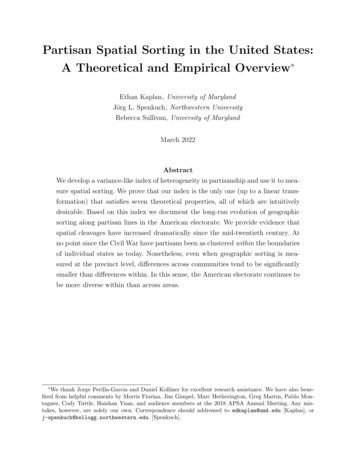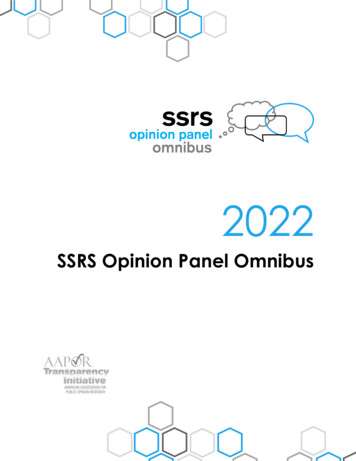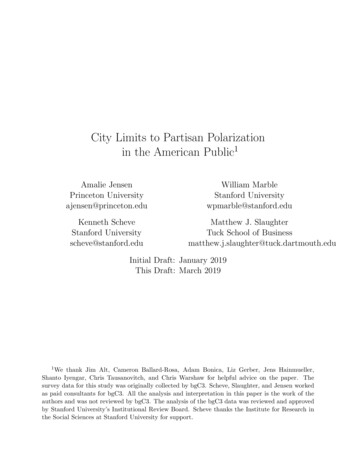
Transcription
City Limits to Partisan Polarizationin the American Public1Amalie JensenPrinceton Universityajensen@princeton.eduKenneth ScheveStanford Universityscheve@stanford.eduWilliam MarbleStanford Universitywpmarble@stanford.eduMatthew J. SlaughterTuck School of ial Draft: January 2019This Draft: March 20191 Wethank Jim Alt, Cameron Ballard-Rosa, Adam Bonica, Liz Gerber, Jens Hainmueller,Shanto Iyengar, Chris Tausanovitch, and Chris Warshaw for helpful advice on the paper. Thesurvey data for this study was originally collected by bgC3. Scheve, Slaughter, and Jensen workedas paid consultants for bgC3. All the analysis and interpretation in this paper is the work of theauthors and was not reviewed by bgC3. The analysis of the bgC3 data was reviewed and approvedby Stanford University’s Institutional Review Board. Scheve thanks the Institute for Research inthe Social Sciences at Stanford University for support.
AbstractHow pervasive is partisan sorting and polarization over public policies in the Americanpublic? We examine whether the patterns of partisan sorting and polarization documentedfor national issues extend to a wide range of important local public policies that shapeeconomic development. Employing conjoint survey experiments in representative surveys foreight U.S. metropolitan areas and a hierarchical modeling strategy for studying heterogeneityacross respondents, we estimate the extent of partisan sorting and polarization over localdevelopment policies. We find that strong partisans are not highly sorted by party, much lesspolarized, in many of their policy opinions. The same voters who disagree about nationalissues have similar preferences about local development issues. We argue that this is largelya result of competitive pressures among local governments that limit disagreements aboutwhat works to improve policy outcomes and the lower salience of partisan cues about theseissues.
1IntroductionHow pervasive is partisan sorting and polarization over public policies in the Americanpublic? An extensive literature has established that voters have become more consistentlysorted in terms of individuals with conservative policy positions on national issues beingmore likely to identify as Republican partisans and those with more liberal policy positionsbeing more likely to identify as Democratic partisans (Abramowitz 2010, Fiorina, Abrams& Pope 2005, Fiorina & Abrams 2008, Levendusky 2009). Some scholars have argued thatthe extent of partisan sorting has resulted in a population with also more polarized nationalpolicy preferences (Abramowitz 2010) while others have argued that this reorganizationof preferences has had little impact on the overall extent to which policy preferences arepolarized (Fiorina & Abrams 2008).Regardless of the extent of polarization, sorting alone is commonly hypothesized to be abarrier to solving national public policy problems. Rather than each policy option havingits own distribution of supporters and opposition and therefore a possibility of cross-cuttingcleavages across issues, sorted partisans have consistently opposing views about how to solvesocial challenges. This sorting of policy preferences is thought not only to reduce the scope forcompromise across issues but also may strengthen affective ties to partisan identities whichin turn makes bipartisan problem-solving less likely (Abramowitz 2006, Brader, Tucker &Therriault 2014, Jacobson 2003, Mason 2015, Gerber, Henry & Lubell 2013).In this paper, we examine whether the patterns of partisan sorting and polarizationdocumented for national issues extend to a wide range of important local public policiesthat shape economic development. Do local development policy preferences — e.g. policiesdesigned to attract businesses, policies that educate and train local workers, policies thatprovide local services, etc. — vary by political partisanship and if so, do partisans haveopposing and therefore polarized positions?Evaluating partisan sorting and polarization over local public policies is important forat least two reasons. First, it provides a new lens for understanding partisan conflict and1
its effect on solving public policy problems. To the extent that localities compete with eachother to retain firms and high income residents, we might expect policy preferences on localpolicies to be constrained and more similar across partisans than national policies. Similarly,to the extent that national media sources primarily provide individuals with informationabout what policy preferences are associated with alternative political parties for nationalproblems, we would again expect more similar policy opinions across partisans for localissues where such information is less available. Studying local public policies can be viewedas evaluating whether partisan identities are pliable enough to be overcome in order to solveproblems when voters are faced with alternative incentives and information.Second, there is a great deal at stake in local development policymaking in the UnitedStates. Where Americans live is a major determinant of their economic opportunities. Globalization, technological change, and other trends that have generated inequality and poorabsolute labor market outcomes for many workers have also made economic growth moregeographically concentrated with some communities faring much better than others. A central problem faced by local governments is how to stimulate economic development amidsttechnological change and international competition. It is therefore important to gain a better understanding of citizen preferences over local development strategies and the potentialoverlap between policies that are economically productive and politically feasible.1We study policy opinions in eight major U.S. Metropolitan Statistical Areas (MSAs):Charlotte, Cleveland, Houston, Indianapolis, Memphis, Rochester, Seattle, and St. Louis.Our analysis is based on a 2018 YouGov survey representative of adult residents in eachMSA.2 We report the results of identical conjoint survey experiments that task respondentswith choosing multiple times between alternative local development plans. Each plan proposed a policy alternative for six different dimensions of local development policymaking:Investment and Taxes, Workers and Entrepreneurs, Local Services, Governance, Education1Economists have historically been skeptical about place-based policies for facilitating economic development, but many think there might be a case for them now (Austin, Glaeser & Summers 2018).2The data were originally produced by bgC3. They have allowed us to use the data and to make itpublicly available upon publication of this paper.2
and Higher Education.We present two main sets of results. The initial estimates report the average componentspecific effect (AMCE) from the conjoint experiment (Hainmueller, Hopkins & Yamamoto2014), pooled and for each city individually. We present evidence that free pre-school, payingteachers more, investing in community colleges, spending on local colleges and universities,creating technical vocational programs, spending more on student grant programs, usingtax and investment incentives to attract new businesses and stimulate existing companies,investing in affordable housing, and spending more on public safety and crime preventionare all policies preferred to the status quo while policies that either expand or limit unionpower and increase investments in charter schools are less preferred than status quo policies.Although there is some heterogeneity in these preferences across MSAs, this broad patterngenerally holds across most of the cities.For purposes of examining partisan sorting and polarization, we estimate conditional average marginal component effects (CAMCE) for Strong Democrats and Strong Republicansto investigate the extent of heterogeneity in the AMCE estimates across partisans in oursample. We focus on strong partisans because we would expect the greatest partisan sortingamong these respondents.3 In the context of our conjoint experiment, we define sorting asDemocrats and Republicans having different CAMCEs — relative to a status quo alternative— for a given policy issue, and polarization as Democrats and Republicans having CAMCEs of opposite signs. The sorting definition is straightforward in that if Democrats andRepublicans have different policy preferences, we expect different policy attributes to havea different effect on their probability of choosing a development plan relative to the statusquo. The polarization definition is useful in that it distinguishes between policies for whichDemocrats and Republicans simply have differential support and those for which a policyoption has opposing effects on the probability that each group supports a development plan.43We report results for all Democratic and Republican identifiers in the Appendix.The literature has typically defined sorting as Democrats having consistently more liberal policy viewsthan Republicans, and polarization as extremity of these opinions. Our definitions are slightly different,but we believe are informative given the conjoint measurement tool that we use. We do not know of other43
We implement two approaches for estimating the CAMCEs for Strong Democrats andStrong Republicans. First, as in Hainmueller, Hopkins & Yamamoto (2014), we estimate thesame OLS regression for estimating the AMCE for the subsamples of interest, in our caseStrong Democrats and Strong Republicans separately. This split-sample approach yieldspoint estimates and confidence intervals of the CAMCEs for each group. This average estimate is informative for our key substantive questions about the extent of partisan sorting andpolarization over local issues. Second, we employ a hierarchical model to estimate CAMCEsfor each individual in the sample conditioned not only on their partisanship but a full profileof observed individual characteristics. This analysis complements the first by allowing us toinvestigate systematic heterogeneity across partisans “controlling for” potential confounding observed variables. Additionally, it allows us to estimate and visualize individual-levelmarginal component effects, allowing us to investigate not just the average opinion, but alsopopulation-level variance in opinions.We find that even among strong partisans there are many areas of local developmentpolicymaking for which Democrats and Republicans have very similar policy preferences.Relative to status quo policies, the effect of using tax and investment incentives to attract newbusinesses and stimulate existing companies, encouraging investments by charities, whetherto consolidate local governments, whether policy autonomy to local governments relativeto the state should be reduced, increasing spending on community colleges, and increasingspending on vocational and technical training on preferred policy bundles is quite similar forStrong Democrats and Strong Republicans. There is essentially no evidence of sorting forthese local policy areas. Moreover, Strong Democrats and Strong Republicans do not havecontrasting preferences — in the sense that the effect of a policy alternative to the statusquo makes one partisan group more likely to choose a policy bundle while making the othergroup less likely to do so — for increasing spending on public safety, expanding studentgrant programs, paying teachers more, and limiting union power. For these issues, there isresearch that explicitly defines sorting and polarization in the context of conjoint survey experiments.4
some evidence of sorting in the sense of one partisan group having strong preferences foror against these policy options but no evidence of polarization understood as these policyoptions having opposing effects. Only a few education and labor issues including schoolvouchers, charter schools, free pre-school, vouchers for worker training, and expanding unionpower have clearly sorted and polarized effects for Strong Democrats and Strong Republicans.The paper makes two contributions. First, partisan sorting and polarization is not aspervasive in American political behavior as is often asserted. Existing empirical research onpartisan sorting and polarization is largely based on national policy issues and our studyprovides new evidence on local policies. Research on partisanship in local politics has focusedon determining the impact of partisan control of local government on public policy outcomes.Recent studies come to somewhat mixed conclusions. Ferreira & Gyourko (2009), employinga regression discontinuity design analysis, find that the partisanship of mayors has no impacton the size of city government and other outcomes. Gerber & Hopkins (2011) also find alimited impact of the partisanship of mayors on policy outcomes with the exception of theshare of the budget spent on public safety, a policy where Democratic mayors spend less andcities have greater discretion than in other policy areas. de Benedictis-Kessner & Warshaw(2016), however, examining a larger set of elections and outcomes, find significant partisaneffects with Democratic mayors spending more and issuing greater debt to do so.This research is important, but regardless of whether mayoral partisanship has an effecton policy outcomes or not, it remains unclear whether citizens themselves have different localpolicy preferences. We could observe or not observe an effect of mayoral partisanship underpolarized or not polarized local public opinion if special interests, the policy preferences ofmayors, competitive constraints on policy, or other considerations influence outcomes. Theliterature on policy outcomes often proposes electoral control as an explanation for partisandifferences, but direct evidence of divergent partisan preferences is limited. An importantexception in this literature is Tausanovitch & Warshaw (2014)’s excellent analysis of thecorrespondence between local public conservatism and local policy. But as they note, their5
measurement approach relies on the assumption that policy opinions on local issues are notdistinct from those on national issues. This may be plausible for their purpose of measuringoverall policy conservatism, but is exactly what we examine empirically in order to assesshow deep partisan sorting and polarization is in the American public.Our evidence suggests only modest levels of partisan sorting and polarization over localdevelopment issues. This may be good news for not only the capacity of cities to developbipartisan solutions to local development challenges but also for the potential for partisansto update their policy opinions in response to incentives and information about effectivepublic policy.5Second, our paper contributes to the local political economy literature. A number ofstudies have documented that since 1980, the convergence across regions in economic development that had characterized most of American history slowed if not reversed itself (Berry& Glaeser 2005, Ganong & Shoag 2017). The economics of agglomeration have led to selfenforcing equilibria in which productive firms and high-human capital individuals find it intheir interest to locate in cities with other productive firms and workers. Slowing convergencehas made the politics of local economic development more pressing than ever before. Ourstudy provides the first extensive, comparable cross-city evidence of what policies individualvoters prefer to create economic development in their cities and how those preferences relateto partisan political conflict.The paper proceeds as follows. The next section discusses the forces that might lead tomore or less partisan sorting and polarization over the policies designed to improve localeconomic outcomes. Section III describes the data and conjoint survey experiment fromeight metropolitan areas that we use to measure local development policy opinions. Thissection also reports the estimates for the AMCE across all eight MSAs pooled and each MSAindividually. Section IV investigates how AMCEs vary by partisanship by presenting split5Rugh & Trounstine (2011) report that strategic politicians in diverse cities use issue bundling to developbroad coalitions for municipal bonds. Our findings suggest that there are similar opportunities to buildbipartisan coalitions in local politics.6
sample estimates of the conditional average marginal component effects for Strong Democratsand Strong Republicans. Section V presents a hierarchical modeling strategy for estimatingCAMCEs and presents these estimates which allow us to investigate partisan differences“controlling for” other observed individual characteristics of respondents. The final sectionconcludes with a discussion of the implications of the results for understanding partisanshipand the politics of local economic development.2Partisan Polarization in Local PoliticsThe objective of this paper is to answer the question of whether local development policypreferences — e.g. policies designed to attract businesses, policies that educate and trainlocal workers, etc. — vary by political partisanship. In this section, we first show that partisans in the eight metropolitan areas considered in this study, like the American electoratemore generally, have substantially different preferences about national policy issues. It is notthe case that the tendency for more liberal voters to sort into urban areas eliminates partisandifferences over national issues. We then outline hypotheses for why partisan polarization inlocal policy preferences might differ from what we see on national issues. We argue that thesame voters who disagree greatly about national issues have fairly similar preferences aboutmany local development issues because competitive pressures among local governments limitdisagreements about what works to improve public policy outcomes and partisan cues aboutthese issues are much less salient.In considering the question of how much partisan sorting and polarization that we shouldexpect to observe about local political issues, it is essential to consider the possibility thatvoters living in cities do not exhibit the same partisan cleavages as the country more generally,even for national issues. If, for example, Republicans who choose to live in cities are moreliberal than other Republicans, we might expect few partisan differences about both nationaland local policy issues simply because Republicans located in cities are not that different7
ideologically than Democrats.6However, several features of our data suggest that ideological geographic sorting into thelarge metropolitan areas that we study is insufficient to eliminate partisan polarization. First,our analysis includes the entire metropolitan statistical area for each city and consequentlya great number of suburban residents, who tend to be more conservative (Nall 2018). Additionally, a number of our MSAs are in relatively Republican states: in all but Seattle at least24% of the respondents identify as Republicans, which is not lower than those identifyingas Democrats. Second, the partisans in our cities have significantly different opinions aboutnational policy issues. Figure 1 reports the results of an OLS regression of several nationalpolicy measures on dummy variables for partisanship, controlling for sociodemographic characteristics.7 There are significant differences in policy positions for all five national issuesand the differences between “Strong Democrats” and “Strong Republicans” are large in magnitude — for most issues, Strong Republicans are at least 20 percentage points more likelyto express a conservative opinion, relative to Strong Democrats.We know that voters in our MSA data are divided on national policy issues and that thisdivide is partly explained by party affiliation. However, is that necessarily the case for localpolicy issues? In the following we present two different hypotheses for why partisan sortingand polarization in preferences for local policies could be different than for national policies:competition among jurisdictions for capital and high-income residents and fewer elite cuesabout what policies go with which partisan orientations at the local level.One aspect of local politics that could affect partisanship in preferences over differentpolicies, is the fact that cities are in competition with each other. Jurisdictions compete forcapital and high-income residents which could make local policy preferences across partisans6There is some debate about the extent of partisan geographic sorting, wtih Bishop (2008) and otherssuggesting that it is pervasive. On the other hand, Mummolo & Nall (2017) show that political sortingmay be rarer than is often hypothesized. Similarly, Martin & Webster (2018) find that the observed level ofpartisan geographic sorting is not sufficient to explain geographic polarization.7For comparability, these control variables are the same as those included in the main results reportedbelow. They include: age, race/ethnicity, sex, education, income, employment status, homeownership status,length of time living in the metro region, and MSA fixed effects.8
Reduce immigration Don't make inequality smaller Reduce safety net Reduce trade Reduce foreign investment 0.00.10.20.30.40.5Strong Republican Strong Democrat DifferenceFigure 1: National Policy Opinions by Partisan Identification. This plot shows differences inopinions between strong Republicans and strong Democrats across a range of national policyissues. The estimates are based on a regression of an indicator for choosing a conservativeresponse to each policy measure on set of dummy variables for partisanship and a numberof sociodemographic characteristics. The bars indicate robust 95% confidence intervals.Across all issues, strong Republicans are at least 10 percentage points more likely to hold aconservative opinion, after controlling for other covariates.(and across areas) converge. Peterson (1981) and others have argued that because citiescompete for firms and need to attract and retain high-income residents, they will have verysimilar policies on many local issues. In particular, we would expect this to be relevant forpolicies that are salient and easy for cities to compete over and for businesses or residentsto act upon, such as tax breaks. To the extent that citizens internalize these constraints,their preferred policies may not vary even if they have very different underlying ideologicalor partisan orientations. This is different from national policies, since mobility of capitaland residents is greater across areas within a country than across countries which increasescompetition.Another mechanism which could limit partisan polarization in local policy preferences isthe fact that there potentially are fewer elite cues about what policies go with which partisan9
orientations at the local level. Hopkins (2018) and others have argued that political behaviorhas become increasingly nationalized. One of the factors contributing to this trend is thatindividuals have less local information about politics as they become increasingly reliant onnational media sources. To the extent that this factor is important, we expect there to besome variation across local development issues as some aspects of local politics, like rulesgoverning union activity, are clearly associated with party policy positions.8Alternative hypotheses point in the opposite prediction: that partisan sorting and polarization might be relatively high for local development policies. First, many of these policiesare related to left-right positions about the optimal size of government and the role of thestate versus markets in organizing economic activity. To the extent that citizens have become more consistently sorted on these issues in national economic policymaking, we mightexpect similar positions on local issues. Second, de Benedictis-Kessner & Warshaw (2016),Gerber, Henry & Lubell (2013), and others have found significant partisan patterns in localpolicymaking which seem plausibly related to underlying differences in the policy preferencesof voters. Additionally, Tausanovitch & Warshaw (2014) find that local policy questions loadonto the same left-right dimension in an ideal point model as national issues.9 Hence, thequestion of whether there are partisan divides in preferences for local development policies isultimately an empirical question, and the remainder of the paper evaluates these competinghypotheses about how deeply partisan polarization pervades American politics.8Another potential reason that preferences over local development policies might be different than thoseover national policies is if voters did not think such policies were important. Indifference might accountfor a lack of partisan conflict about local issues. Appendix Section B evaluates this possibility by reportingthe frequency that different issues are mentioned when respondents gave open-ended answers to the prompt“What do you think are the major issues facing people in the [MSA Name] area these days?” The distributionof answers suggest unsurprisingly that voters prioritize local development issues generally and are specificallyfocused on the local policy issues that we will study below.9That said, the factor loadings are generally lower for municipal policy questions than for national issues— especially on local development policy such as tax incentives to businesses (p. 628) — suggesting thatlocal preferences may be related to but distinct from national policy preferences.10
3Local Development Policy PreferencesTo measure public preference over local development policies, we report the results of achoice-based conjoint survey experiment that varied attributes of proposed local developmentplans for eight large U.S. Metropolitan Statistical Areas (MSAs): Charlotte, Cleveland,Houston, Indianapolis, Memphis, Rochester, St. Louis, and Seattle. The surveys wereconducted by YouGov in January and February 2018 and are representative samples of theadult population of each MSA.10 These MSAs were selected based on three main criteria:Each MSA needed to be large enough so that it was possible to construct a representativesample using YouGov’s panel and matched sampling methodology; the MSAs needed to beselected from different regions of the U.S.; and the MSAs needed to vary in their economicdevelopment success over the last four decades. Given these characteristics, this set of MSAsshould provide a reasonable guide to local development policy preferences across large U.S.MSAs though as we document here there are some important differences across cities withinthe sample and thus we would expect some variation for cities not in the sample as well.3.1Conjoint ExperimentConsistent with our interest in how individuals think about local public policy problemsolving and with recent trends in the drivers of local economic performance, the conjointexperiment is framed in terms of how the MSA should respond to globalization and technological change and implement policies that will generate economic growth and good jobs.The specific wording of the conjoint introduction is:Now we’d like to ask you some questions about [MSA Name].Given the impact of globalization and technological change on the [MSA Name]economy in the past and their potential impact in the future, there are lots ofdifferent ideas about the policies that [MSA Name] should adopt to generateeconomic growth and good jobs for its citizens. We want to know what youthink.10See Appendix A for full description of sampling methodology and descriptive statistics.11
We will provide you with several possible development plans to help [MSA Name]adapt to technology and globalization. Please remember that any new spendingprograms will require higher taxes or spending cuts to existing programs. Similarly, any tax cuts will require offsetting tax increases or spending cuts. We willalways show you two possible proposals in comparison. For each comparison,please indicate which of the two plans you prefer. Please just tell us which oneyou like best. You may like both or not like either one. In any case, choose theone you prefer the most. In total, we will show you five comparisons.People have different opinions about these issues, and there are no right or wronganswers. Please take your time when reading the potential plans.Respondents were presented with pairs of hypothetical plans for local development. Eachplan was composed of six attributes corresponding to six critical areas of local developmentpolicymaking: Investment & Taxes, Workers & Entrepreneurs, Local Services, Governance,Education, and Higher Education. For each issue area, a possible value was randomly drawnfrom an underlying set of potential values that included alternative reform or spendingpriorities as well as the status quo in that policy area. For example, in the Educationdimension, options included Expand charter schools, Give citizens vouchers that they canuse to attend different schools, Provide more children with free pre-school, Pay teachersmore to attract better teachers, and Keep current elementary and secondary school policies.Table 1 lists each possible value for each dimension. Finally, it is important to keep in mindthat the introduction to the conjoint experiment emphasized that increased spending wouldrequire tax increases or spending reductions in other areas.Respondents were presented with randomly-generated pairs of potential policies for theirMSA to adopt as a local development plan and were asked to choose which plan they wouldprefer to see implemented.11 Using this style of forced-choice design, we are able to evaluatethe direction and relative weight individuals place on each dimension of local development.Respondents were presented with five sets of local development plan pairs. For our analysis
Tuck School of Business matthew.j.slaughter@tuck.dartmouth.edu Initial Draft: January 2019 . power and increase investments in charter schools are less preferred than status quo policies. . quo makes one partisan group more likely to choose a policy bundle while making the other group less likely to do so for increasing spending on public .
